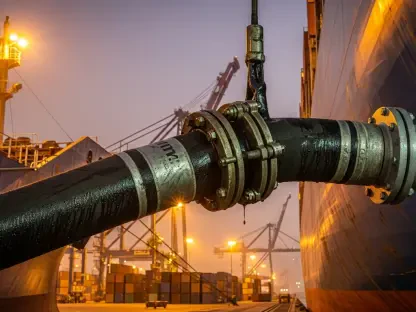The recent escalation in military tensions surrounding the Strait of Hormuz, a strategic maritime passage, has significantly impacted global oil and liquefied natural gas (LNG) shipments. Known as a vital conduit through which around 20% of the world’s oil and substantial LNG volumes travel, the Strait has become a focal point of geopolitical friction. Recent developments saw the United States launching strikes on Iranian nuclear sites, a move intensifying concerns over the potential repercussions on international trade. This action aligns with broader regional objectives, notably those shared with Israel, aiming to curtail Iran’s nuclear development. In response, a notable shift in shipping operations through the Strait has been observed, predominantly driven by increased security risks and uncertainty in the region.
Impact of Geopolitical Tensions on Shipping
Following the U.S. military strikes on Iran, there has been a palpable shift in the navigation patterns of vessels transiting through the Strait of Hormuz. Reports from BIMCO, a notable shipping association, highlight a decline in ship movements as companies exercise heightened caution or temporarily suspend passages. This cautious approach echoes the broader sentiment of anxiety permeating the shipping industry, which must navigate the intricate interplay of trade interests and geopolitical dynamics. The Strait, already recognized as one of the world’s most critical oil chokepoints, sees operators recalibrating their strategies. They must balance maintaining operational continuity against the heightened likelihood of confrontation, a balance complicated by the Iranian parliament’s potential motion to close the Strait, a move that could severely disrupt regional and global trade dynamics.
The impact of such disruptions extends beyond logistical concerns, threatening to inflate energy prices and amplify shipping costs worldwide. A prolonged closure or substantial restriction in the Strait could resonate through global energy markets, impacting economies that rely heavily on stable oil and LNG supplies. This creates a complex scenario where industry leaders advocate for meticulous risk assessment and strategic judiciousness. Companies shipping through the Strait, such as Japan’s Nippon Yusen and Mitsui O.S.K. Lines, are opting for preventive measures, including scheduling adjustments and emergency contingencies. Such strategies reflect an industry on high alert, poised to adapt swiftly to any further escalations, underscoring the interconnectedness of trade flows, energy security, and geopolitical stability.
Strategic Responses and Global Reactions
Shipping companies are adjusting their operational practices to counteract potential threats, embodying a cautious yet calculated approach. By adopting adjusted schedules and minimizing time spent in the Persian Gulf, these enterprises exhibit a preparedness to respond to uncalculated risks. The Orient is not the only region reacting; European entities like Hapag-Lloyd continue their operations but are poised with emergency protocols ready for rapid deployment. These layers of contingency planning illustrate the broader strategic shift toward unpredictability management, emphasizing preparedness over passive waiting amid fluctuating geopolitical narratives.
Beyond industry responses, global stakeholders are being drawn into the conversation regarding the Strait’s future. Insurers, for their part, have recalibrated risk assessments, leading to increased costs for shipping through the affected region. Furthermore, major global players, including Washington and possibly Beijing, are reportedly intensifying their engagement in Middle Eastern dialogues, reflecting an international effort to mitigate the implications of a potential Strait closure. This landscape is creating a confluence of economic, military, and political domains, where multinational cooperation is seen as essential to averting a possible energy crisis and ensuring sustainable trade flows.
Looking Ahead: Navigating a Complex Geopolitical Landscape
After the U.S. military strikes on Iran, a noticeable change has occurred in the navigation routes of ships passing through the Strait of Hormuz. According to BIMCO, a prominent shipping association, there’s been a reduction in ship movements as companies become more cautious, with some even halting transit temporarily. This cautious stance reflects the broader anxiety within the shipping industry as it negotiates the complex relationship between trade interests and geopolitical tensions. The Strait, a vital oil chokepoint globally, sees operators adjusting their strategies to maintain operations while facing the risk of conflict. This delicate balance is further complicated by potential Iranian parliamentary actions to close the Strait, which could severely impact both regional and global trade. Such disruptions could spike energy prices and increase shipping costs worldwide. The threat of a prolonged closure could ripple through global energy markets, affecting economies dependent on stable supplies of oil and LNG. In response, industry leaders stress the need for comprehensive risk assessment and strategic planning. Companies like Japan’s Nippon Yusen and Mitsui O.S.K. Lines are taking precautionary steps, including schedule changes and emergency plans, to be ready for any further escalations. This highlights the interconnected nature of trade, energy security, and geopolitical stability.









